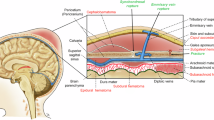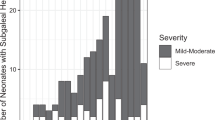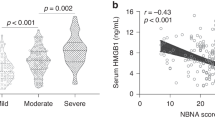Abstract
Background
Subgaleal hemorrhage (SGH) is reported to be associated with severe hemodynamic instability, coagulopathy, and even mortality. The importance of the presence or absence of neonatal encephalopathy in predicting SGH outcomes has not been explored. The aim of this study was to determine the relationship of clinical encephalopathy to short-term outcomes in neonates with SGH.
Methods
Neonates ≥35 weeks gestation, diagnosed radiologically with SGH between 2010 and 2017, were included. Cases were divided into encephalopathic and non-encephalopathic. Demographic, clinical, and outcome data were compared between groups.
Results
Of 54,048 live births, 56 had SGH, of them 13 (23%) had encephalopathy. When compared to the non-encephalopathic neonates, encephalopathic neonates had lower Apgar scores, lower hemoglobin, lower platelet count, longer neonatal intensive care unit stay, two (15%) deaths, and four (31%) required blood transfusion. No non-encephalopathic infant with SGH died or required blood transfusion. Notably, on magnetic resonance imaging (MRI), a majority of subgaleal collections had either no or minimal blood products.
Conclusions
In the absence of encephalopathy, SGH is not associated with adverse short-term outcome. Neurological assessment is likely to identify infants at higher risk for adverse outcome. The absence of MRI signal consistent with blood in subgaleal collection warrants further research.
Similar content being viewed by others
Log in or create a free account to read this content
Gain free access to this article, as well as selected content from this journal and more on nature.com
or
References
Govaert, P., Vanhaesebrouck, P., De Praeter, C., Moens, K. & Leroy, J. Vacuum extraction, bone injury and neonatal subgaleal bleeding. Eur. J. Pediatr. 151, 532–535 (1992).
Ahuja, G. L., Willoughby, M. L. N., Kerr, M. M. & Hutchison, J. H. Massive subaponeurotic haemorrhage in infants born by vacuum extraction. BMJ 3, 743–745 (1969).
Williams, M. F., Jacobs, M. & Moosa, A. Subaneurotic haemorrhage of the newborn. S. Afr. Med. J. 52, 176–178 (1977).
Uchil, D. & Arulkumaran, S. Neonatal subgaleal hemorrhage and its relationship to delivery by vacuum extraction. Obstet. Gynecol. Surv. 58, 687–693 (2003).
Boo, N. Y., Foong, K. W., Mahdy, Z. A., Yong, S. C. & Jaafar, R. Risk factors associated with subaponeurotic haemorrhage in full-term infants exposed to vacuum extraction. BGOJ Int. J. Obstet. Gynaecol. 112, 1516–1521 (2005).
Plauché, W. C. Subgaleal hematoma: a complication of instrumental delivery. JAMA 244, 1597–1598 (1980).
Ng, P., Siu, Y. & Lewindon, P. Subaponeurotic haemorrhage in the 1990s: a 3‐year surveillance. Acta Pædiatr. 84, 1065–1069 (1995).
Gebremariam, A. Subgaleal haemorrhage: risk factors and neurological and developmental outcome in survivors. Ann. Trop. Paediatr. 19, 45–50 (1999).
Christensen, R. D., Baer, V. L. & Henry, E. Neonatal sub-galeal hemorrhage in a multihospital healthcare system: prevalence, association and outcomes. Eur. J. Neonatol. Res. 1, 4–11 (2011).
Swanson, A. E., Veldman, A., Wallace, E. M. & Malhotra, A. Subgaleal hemorrhage: risk factors and outcomes. Acta Obstet. Gynecol. Scand. 91, 260–263 (2012).
Boo, N. Y. Subaponeurotic haemorrhage in Malaysian neonates. Singap. Med. J. 31, 207–210 (1990).
Chang, H.-Y. et al. Neonatal subgaleal hemorrhage: clinical presentation, treatment, and predictors of poor prognosis. Pediatr. Int. 49, 903–907 (2007).
Adedoyin, O. T., AWBR, Johnson, Mokuolu, O. A. & Ajayi, O. A. Acute renal failure complicating neonatal sub-galeal hemorrhage [3]. Pedia. Nephrol. 18, 848–849 (2003).
Chadwick, L. M., Pemberton, P. J. & Kurinczuk, J. J. Neonatal subgaleal haematoma: associated risk factors, complications and outcome. J. Paediatr. Child Health 32, 228–232 (1996).
Colditz, M. J., Lai, M. M., Cartwright, D. W. & Colditz, P. B. Subgaleal haemorrhage in the newborn: a call for early diagnosis and aggressive management. J. Paediatr. Child Health 51, 140–146 (2015).
2014 Executive summary: Neonatal encephalopathy and neurologic outcome, second edition. Report of the American College of Obstetricians and Gynecologists’ Task Force on Neonatal Encephalopathy. Obstet. Gynecol. 123, 896–901 (2014).
Shankaran, S. et al. Evolution of encephalopathy during whole body hypothermia for neonatal hypoxic–ischemic encephalopathy. J. Pediatr. 160, 567–572 e563 (2012).
Naidich, T. P. Imaging of the Brain pp xv, 1052pp (Saunders/Elsevier, Philadelphia, 2013).
Lee, J. J. & Wenger T. L. Delayed subaponeurotic fluid collections of infancy. J. Pediatr 197, 310–310.e1 (2018).
Wang, S., Drake, J. & Kulkarni, A. V. Management and outcome of spontaneous subaponeurotic fluid collections in infants: the Hospital for Sick Children experience and review of the literature. J. Neurosurg. Pediatr. 18, 442–447 (2016).
Hopkins, R. E., Inward, C., Chambers, T. & Grier, D. Sub-aponeurotic fluid collections in infancy. Clin. Radiol. 57, 114–116 (2002).
Petraglia, A. L., Moravan, M. J., Marky, A. H. & Silberstein, H. J. Delayed sub-aponeurotic fluid collections in infancy: three cases and a review of the literature. Surg. Neurol. Int. 1, 34 (2010). Available from: https://surgicalneurologyint.com/surgicalint-articles/delayed-sub-aponeurotic-fluid-collections-in-infancy-three-cases-and-a-review-of-the-literature/
Schoberer, A. et al. Sub-aponeurotic fluid collections: a delayed-onset self-limiting cerebrospinal fluid fistula in young infants. Eur. J. Paediatr. Neurol. 12, 401–403 (2008).
Smith, A. et al. Delayed infant subaponeurotic (subgaleal) fluid collections: a case series of 11 infants. J. Emerg. Med. 50, 881–886 (2016).
Author information
Authors and Affiliations
Contributions
M.E.-D. had substantial contributions to conception and design, data analysis, and interpretation of data. He also drafted the article and had final approval of the version to be published. M.P. had substantial contributions to conception and design, acquisition of data, analysis, and interpretation of data. She co-drafted the article and had final approval of the version to be published. L.J. had substantial contributions to conception and design, acquisition, and interpretation of data. She contributed to revising it critically for important intellectual content, and had final approval of the version to be published. C.B.B. had substantial contributions to conception and design, acquisition, and interpretation of data. She contributed to revising it critically for important intellectual content, and had final approval of the version to be published. P.E.G. had substantial contributions to conception and design, acquisition, and interpretation of data. She contributed to revising it critically for important intellectual content, and had final approval of the version to be published. J.R. had substantial contributions to conception and interpretation of data. He contributed to revising it critically for important intellectual content, and had final approval of the version to be published. J.J.V. had substantial contributions to conception and interpretation of data. He contributed to revising it critically for important intellectual content, and had final approval of the version to be published. T.I. had substantial contributions to conception and interpretation of data. She contributed to revising it critically for important intellectual content, and had final approval of the version to be published.
Corresponding author
Ethics declarations
Competing interests
The authors declare no competing interests.
Additional information
Publisher’s note: Springer Nature remains neutral with regard to jurisdictional claims in published maps and institutional affiliations.
Rights and permissions
About this article
Cite this article
El-Dib, M., Parziale, M., Johnson, L. et al. Encephalopathy in neonates with subgaleal hemorrhage is a key predictor of outcome. Pediatr Res 86, 234–241 (2019). https://doi.org/10.1038/s41390-019-0400-1
Received:
Revised:
Accepted:
Published:
Issue date:
DOI: https://doi.org/10.1038/s41390-019-0400-1
This article is cited by
-
Subgaleal hemorrhage in neonates: a comprehensive review and summary recommendations
Journal of Perinatology (2025)
-
Unconjugated bilirubin is correlated with the severeness and neurodevelopmental outcomes in neonatal hypoxic-ischemic encephalopathy
Scientific Reports (2023)
-
Neonatal subgaleal hemorrhage: twenty years of trends in incidence, associations, and outcomes
Journal of Perinatology (2023)



